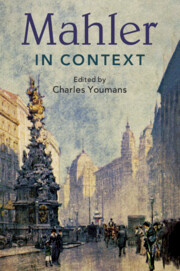30 results
Notes on Contributors
-
- Book:
- Mahler in Context
- Published online:
- 18 December 2020
- Print publication:
- 19 November 2020, pp xii-xx
-
- Chapter
- Export citation
Part III - Creation
-
- Book:
- Mahler in Context
- Published online:
- 18 December 2020
- Print publication:
- 19 November 2020, pp 99-170
-
- Chapter
- Export citation

Mahler in Context
-
- Published online:
- 18 December 2020
- Print publication:
- 19 November 2020
Figures
-
- Book:
- Mahler in Context
- Published online:
- 18 December 2020
- Print publication:
- 19 November 2020, pp x-x
-
- Chapter
- Export citation
Part II - Performance
-
- Book:
- Mahler in Context
- Published online:
- 18 December 2020
- Print publication:
- 19 November 2020, pp 63-98
-
- Chapter
- Export citation
Copyright page
-
- Book:
- Mahler in Context
- Published online:
- 18 December 2020
- Print publication:
- 19 November 2020, pp iv-iv
-
- Chapter
- Export citation
Further Reading
-
- Book:
- Mahler in Context
- Published online:
- 18 December 2020
- Print publication:
- 19 November 2020, pp 300-310
-
- Chapter
- Export citation
Part V - Influence
-
- Book:
- Mahler in Context
- Published online:
- 18 December 2020
- Print publication:
- 19 November 2020, pp 233-299
-
- Chapter
- Export citation
Music Examples
-
- Book:
- Mahler in Context
- Published online:
- 18 December 2020
- Print publication:
- 19 November 2020, pp xi-xi
-
- Chapter
- Export citation
Part IV - Mind, Body, Spirit
-
- Book:
- Mahler in Context
- Published online:
- 18 December 2020
- Print publication:
- 19 November 2020, pp 171-232
-
- Chapter
- Export citation
Dedication
-
- Book:
- Mahler in Context
- Published online:
- 18 December 2020
- Print publication:
- 19 November 2020, pp v-vi
-
- Chapter
- Export citation
Abbreviations
-
- Book:
- Mahler in Context
- Published online:
- 18 December 2020
- Print publication:
- 19 November 2020, pp xxv-xxvi
-
- Chapter
- Export citation
Chapter 5 - Viennese Musical Associates, 1875–1883
- from Part I - Formation
-
-
- Book:
- Mahler in Context
- Published online:
- 18 December 2020
- Print publication:
- 19 November 2020, pp 40-47
-
- Chapter
- Export citation
Part I - Formation
-
- Book:
- Mahler in Context
- Published online:
- 18 December 2020
- Print publication:
- 19 November 2020, pp 1-62
-
- Chapter
- Export citation
Index
-
- Book:
- Mahler in Context
- Published online:
- 18 December 2020
- Print publication:
- 19 November 2020, pp 311-320
-
- Chapter
- Export citation
Contents
-
- Book:
- Mahler in Context
- Published online:
- 18 December 2020
- Print publication:
- 19 November 2020, pp vii-ix
-
- Chapter
- Export citation
Chapter 25 - Romantic Relationships
- from Part IV - Mind, Body, Spirit
-
-
- Book:
- Mahler in Context
- Published online:
- 18 December 2020
- Print publication:
- 19 November 2020, pp 216-224
-
- Chapter
- Export citation
Preface and Acknowledgments
-
- Book:
- Mahler in Context
- Published online:
- 18 December 2020
- Print publication:
- 19 November 2020, pp xxi-xxiv
-
- Chapter
- Export citation
Chapter 16 - Philosophy and Religion
- from Part III - Cultural Engagement and Musical Life
-
-
- Book:
- Richard Strauss in Context
- Published online:
- 08 October 2020
- Print publication:
- 29 October 2020, pp 145-152
-
- Chapter
- Export citation
Chapter 35 - 2001: A Space Odyssey and Beyond
- from Part VI - Artifacts and Legacy
-
-
- Book:
- Richard Strauss in Context
- Published online:
- 08 October 2020
- Print publication:
- 29 October 2020, pp 320-328
-
- Chapter
- Export citation



